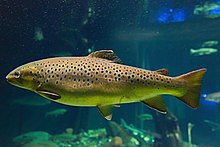| Brown trout | |
|---|---|

| |
| Scientific classification | |
| Domain: | Eukaryota |
| Kingdom: | Animalia |
| Phylum: | Chordata |
| Class: | Actinopterygii |
| Order: | Salmoniformes |
| Family: | Salmonidae |
| Genus: | Salmo |
| Species: | S. trutta
|
| Binomial name | |
| Salmo trutta | |
| Morphs | |
|
Salmo trutta morpha trutta | |
| Synonyms[2] | |
|
previous scientific names
| |
The brown trout (Salmo trutta) is a species of salmonid ray-finned fish and the most widely distributed species of the genus Salmo, endemic to most of Europe, West Asia and parts of North Africa, and has been widely introduced globally as a game fish, even becoming one of the world's worst invasive species outside of its native range.
Brown trout are highly adaptable and have evolved numerous ecotypes/subspecies. These include three main ecotypes: a riverine ecotype called river trout or Salmo trutta morpha fario; a lacustrine ecotype or S. trutta morpha lacustris, also called the lake trout (not to be confused with the lake trout in North America);[3][4] and anadromous populations known as the sea trout or S. trutta morpha trutta, which upon adulthood migrate downstream to the oceans for much of its life and only returns to fresh water to spawn in the gravel beds of headstreams.[citation needed] Sea trout in Ireland and Great Britain have many regional names: sewin in Wales, finnock in Scotland, peal in the West Country, mort in North West England, and white trout in Ireland.
The lacustrine and riverine morphs of brown trout are both potamodromous, meaning they are also migratory, though only between freshwater bodies. Lacustrine trout mainly inhabit large lakes with calm and stratified deep water, while riverine trout forms fluvial populations typically in large rivers but sometimes in shallower creeks and alpine streams, both still migrating upstream during reproductive seasons. Anadromous and potamodromous morphs coexisting in the same river appear genetically identical.[5] What determines whether they migrate to sea or not remains unknown.
- ^ Freyhof, J. (2011). "Salmo trutta". IUCN Red List of Threatened Species. 2011: e.T19861A9050312. doi:10.2305/IUCN.UK.2008.RLTS.T19861A9050312.en. Retrieved 12 November 2021.
- ^ "Synonyms of Salmo trutta Linnaeus, 1758". Fishbase.org. Retrieved 2014-02-22.
- ^ Derwent Publications, Thesaurus of Agricultural Organisms, Vol. 1, London: Chapman and Hall, 1990, p. 1058.
- ^ E. Brown, World Fish Farming: Cultivation and Economics, Connecticut: AVI, 1983, p. 93.
- ^ Lack of genetic differentiation between anadromous and resident sympatric brown trout (Salmo trutta) in a Normandy population. Archived 2007-05-18 at the Wayback Machine. In Aquatic Living Resources, Volume 18, N° 1, January–March 2005. Pages 65–69.
